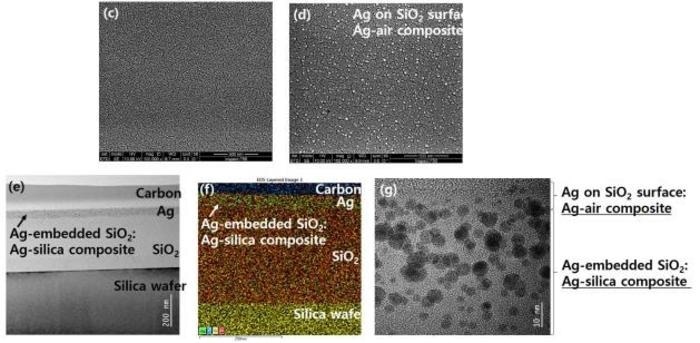Since the outbreak of COVID-19, people have become accustomed to seeing antiviral films applied to elevator buttons and transportation handles. However, traditional antiviral films are created by combining antiviral metal particles with polymers. Due to the production process, only a small portion of these metal particles are visible on the surface. As a result, contrary to popular assumption, these films do not provide considerable antiviral protection when in touch with the film surface.
 SEM/TEM analysis of the silica layer showing well-defined silver nanoparticles on the surface. Image Credit: Korea Institute of Science and Technology (KIST)
SEM/TEM analysis of the silica layer showing well-defined silver nanoparticles on the surface. Image Credit: Korea Institute of Science and Technology (KIST)
According to a joint research team led by Dr. So-Hye Cho of the Materials Architecturing Research Center and Dr. Seung Eun Lee of the Research Animal Resources Center, a collaborative research team at the Korea Institute of Science and Technology (KIST) has invented a nanocoating technology that not only optimizes the antiviral activity of the surface but also makes different colors possible.
The study team created an efficient antiviral and antibacterial surface by first employing the sol-gel technique to build a silica coating layer on diverse surfaces, then covering the silica layer with silver (Ag) nanoparticles in an aqueous solution containing silver. In turn, silver nanoparticles reduce virus infectivity by adhering to proteins on the virus’s surface, altering the virus's structure and function and making it harder for the virus to enter cells.
Conventional antiviral films have antiviral functional metal particles placed inside the thin film, making it impossible for silver to come into contact with viruses. However, the technique created by the KIST research team showed extraordinary activity when a small amount of silver nanoparticles was placed on the thin film’s surface.
Experiments with lentiviruses, produced as coronavirus analogs, revealed a virus elimination rate that was more than twice as quick as commercial films.
Furthermore, antibacterial testing against E. coli showed 100% eradication of the germs within 24 hours. The proposed antiviral coating method also has the benefit of delivering numerous colors by managing light interference with varied coating layer thicknesses.
This metal nanoparticle coating technology demonstrates superior antiviral and antibacterial effects compared to commercial products, even with a small coating of less than 1 g/m2, so its industrialization potential is very high. It can be used in various industries such as medical materials, home appliances, and building materials to help manage microorganisms and prevent infections by implementing antiviral and antibacterial effects.
Dr. So-Hye Cho, Principal Researcher, Materials Architecturing Research Center, Korea Institute of Science and Technology
The study, which was funded by the Ministry of Science and ICT through the Korea Research Foundation-Nano and Materials Technology Development Project (2020M3H4A3106354), KIST Future Source Research Project (2E32511), and K-DARPA Innovative Technology Development Project, was released online in the international journal ACS Applied Materials and Interfaces on November 9th, 2023.
Journal Reference:
Fu, X., et. al. (2024) In Situ Metal Deposition on Perhydropolysilazane-Derived Silica for Structural Color Surfaces with Antiviral Activity. ACS Applied Materials & Interfaces. doi:10.1021/acsami.3c12622.